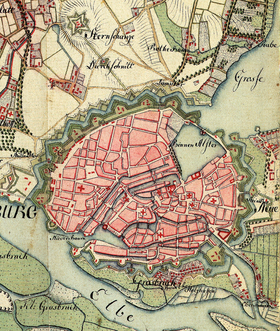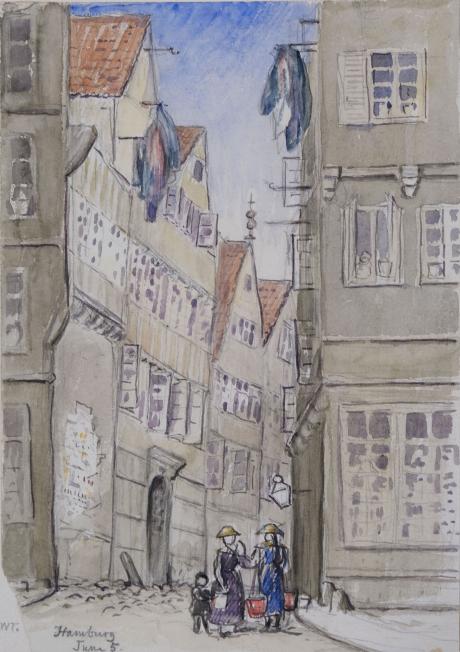inscribed and dated " Hamburg June 5th 1869 " and signed with initials "LWT"
Tom and Laura Taylor and thence by descent
Altstadt more precisely Hamburg-Altstadt – as not to be mistaken with Hamburg-Altona-Altstadt – is one of the inner-city districts of the Free and Hanseatic City of Hamburg, Germany.

The area of today's Altstadt had a minor Bronze Age settlement dating from the 9th or 8th century BC. An Ingaevonian settlement at this location was known by the name "Treva" – a strategic trading node on amber routes during Iron Age and Late Antiquity.
In the 8th century CE, Saxon merchants established what was to become the nucleus of Hamburg: the "Hammaburg", then a refuge fort located at today's Domplatz, the site of the former cathedral.[3] Under Frankish rule, a baptistery was installed in 804 and Hammaburg strengthened by Charlemagne in 811. Quickly, the place grew to a sizable market town, declared a bishop's see in 831, an archbishop's see a year later. For the next 600 years, the history of Altstadt was equivalent to the history of Hamburg.
By the end of the 15th century, the then Hanseatic city-republic and free Imperial city had accumulated various territorial possessions in its hinterland. Eventually, Hamburg's 13th-century city-walls received a couple of extensions: first in the 1530s, then again in the 1620s to include all of adjacent Neustadt.
Regarding the urban history of Altstadt, only a few structures prior to the 17th century are left: repeated damming and diverting of the Alster and its canals, the Great Fire (1842), the bombing in World War II (1941–1945) and modern infrastructure projects (particularly during the 1880s to 1900s, 1920s and 1950s to 1970s) left Hamburg's inner-city with a mainly 19th and 20th-century built environment.


The Hammaburg, Hamburg's origin, was established on a former headland, between the confluences of Alster and Bille into the Elbe Stream. Over the centuries Alster and Bille were impoldered and diverted several times, resulting in an ever different geography. Today, Altstadt is bordered by Alster (i.e. Alsterfleet and Binnenalster) to the West and North-West, the rail tracks of Hamburg-Altona link line and Hauptbahnhof to the East, and Zollkanal to the South.
Districts bordering Hamburg-Altstadt are (starting clockwise in the North-West): Neustadt, St. Georg, Hammerbrook and HafenCity.
The single most important square in Altstadt is Rathausmarkt, both by location and function. It is the starting point of Alter Wall, Reesendamm/Ballindamm, Mönckebergstraße and Große Johannisstraße/Großer Burstah, all important streets in Altstadt. Other important squares in Altstadt include Burchardplatz, Domplatz, Gerhart-Hauptmann-Platz, and Hopfenmarkt.
-
Ferdinandstraße
The eastern end of Altstadt is encircled by "Ring 1" (Glockengießerwall, Steintorwall), a 1880s-built ring road continuing into Neustadt. Willy-Brandt-Straße is part of Bundesstraße 4, a 1960s-built thoroughfare, crossing Altstadt midway from East to West.
Deichstraße (lit. "dike street") is the oldest remaining street in the Altstadt of Hamburg, Germany and a popular visitor attraction in the city.
Deichstraße dates back to the 14th century; it was first mentioned in 1304. Located adjacent to Nikolaifleet and close to the Speicherstadt, it now contains carefully restored 17th–19th-century houses, all that is left of the old harbour district. The Great Fire of 1842 broke out in Deichstraße 42 and destroyed many of the original buildings, but spared the southern end of the street spreading - driven by the wind - mostly northeastwards. Today, Deichstraße –along with Neustadt's Peterstraße– contains some of the oldest buildings in the city, including the oldest warehouse, at Peterstraße 27, built in 1780.
Laura Wilson Barker (6 March 1819 – 22 May 1905), was a composer, performer and artist, sometimes also referred to as Laura Barker, Laura W Taylor or "Mrs Tom Taylor".
She was born in Thirkleby, North Yorkshire, third daughter of a clergyman, the Rev. Thomas Barker. She studied privately with Cipriani Potter and became an accomplished pianist and violinist. As a young girl Barker performed with both Louis Spohr and Paganini. She began composing in the mid-1830s - her Seven Romances for voice and guitar were published in 1837. From around 1843 until 1855 she taught music at York School for the Blind. During this period some of her compositions - including a symphony in manuscript, on 19 April 1845 - were performed at York Choral Society concerts.
On 19 June 1855 she married the English dramatist, critic, biographer, public servant, and editor of Punch magazine Tom Taylor. Barker contributed music to at least one of her husband's plays, an overture and entr'acte to Joan of Arc (1871), and provided harmonisations as an appendix to his translation of Ballads and Songs of Brittany (1865).
Her other works include the cantata Enone (1850), the violin sonata A Country Walk (1860), theatre music for As You Like It, (April 1880), Songs of Youth (1884), string quartets, madrigals and solo songs. Her choral setting of Keats's A Prophecy, composed in 1850, was performed for the first time 49 years later at the Hovingham Festival in 1899. The composer was present.
Several of Barker's paintings hang at Smallhythe Place in Kent, Ellen Terry's house.
Barker lived with her husband and family at 84 Lavender Sweep, Battersea. There were two children: the artist John Wycliffe Taylor (1859–1925), and Laura Lucy Arnold Taylor (1863–1940). The Sunday musical soirees at the house attracted many well-known attendees, including Lewis Carroll, Charles Dickens, Henry Irving, Charles Reade, Alfred Tennyson, Ellen Terry and William Makepeace Thackeray.
Tom Taylor died suddenly at his home in 1880 at the age of 62. After his death, his widow retired to Porch House, Coleshill in Buckinghamshire, where she died on 22 May 1905, aged 86.






